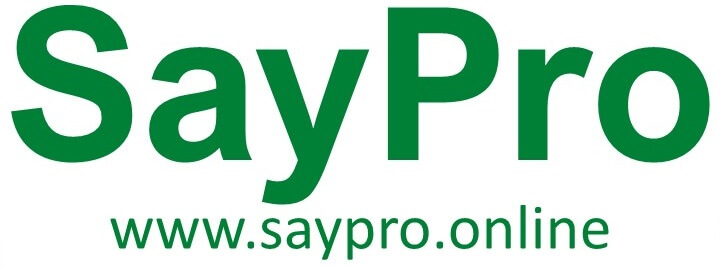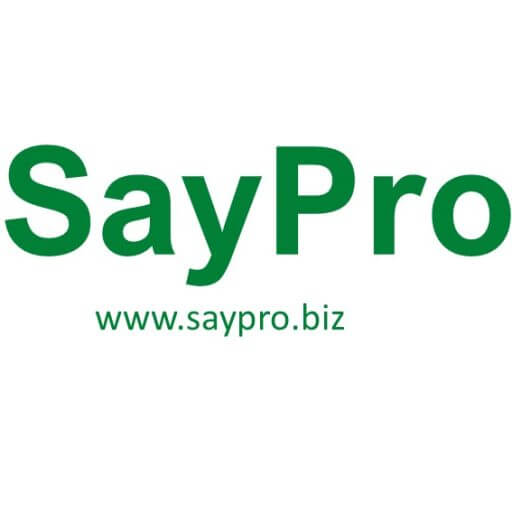Your basket is currently empty!
SayPro Educational Needs Assessments Research Volunteer

Website SayPro
SayPro Educational Needs Assessments Research Volunteer
Position: SayPro Educational Needs Assessments Research Volunteer
Description: Are you passionate about education and eager to make a tangible difference? SayPro is seeking dedicated volunteers to join our team in conducting educational needs assessments. As a Research Volunteer, you’ll play a crucial role in helping us identify and address the gaps in educational resources and opportunities within various communities.
SayPro Key Responsibilities:
– Conduct Research: Gather and analyze data on educational needs through surveys, interviews, and field observations.
– Data Analysis: Compile and interpret data to identify trends, challenges, and areas for improvement in educational programs and resources.
– Report Findings: Prepare detailed reports and presentations to communicate findings to stakeholders and contribute to strategic planning.
– Collaborate: Work closely with educational professionals, community members, and other volunteers to gather insights and validate findings.
– Support Development: Assist in the creation of recommendations and strategies for enhancing educational programs based on research outcomes.
SayPro Qualifications:
– Strong interest in education and community development.
– Excellent research and analytical skills.
– Proficiency in data collection and analysis tools.
– Effective communication skills, both written and verbal.
– Ability to work independently and as part of a team.
– Experience in research or a related field is a plus, but not required.
SayPro Benefits:
– Gain hands-on experience in educational research and needs assessment.
– Contribute to meaningful projects that impact educational policy and practice.
– Network with professionals and experts in the field of education.
– Receive training and support from experienced mentors.
Join us at SayPro and be part of a team dedicated to improving educational outcomes and opportunities for all. Your contributions will help shape the future of education and empower communities to thrive. Apply today to make a difference!
SayPro Research Objectives
SayPro Identify Educational Gaps:
Needs Identification: Determine the specific educational needs and gaps within a population or institution.
Resource Assessment: Evaluate the adequacy and effectiveness of existing educational resources and programs.
SayPro Understand Stakeholder Needs:
Student Needs: Assess the educational needs and preferences of students, including their learning styles and support requirements.
Educator Needs: Identify the professional development and resource needs of educators to improve their teaching effectiveness.
SayPro Evaluate Program Effectiveness:
Current Program Review: Analyze the effectiveness of existing educational programs and services in addressing identified needs.
Program Improvement: Develop recommendations for enhancing or redesigning programs to better meet educational needs.
SayPro Develop Actionable Insights:
Strategic Planning: Provide data-driven insights for strategic planning and decision-making in educational institutions.
Resource Allocation: Inform decisions on resource allocation and prioritization to address identified educational needs.
SayPro Research Methodologies
SayPro Needs Assessment:
Surveys and Questionnaires: Distribute surveys and questionnaires to students, educators, and other stakeholders to gather information on educational needs and preferences.
Interviews: Conduct interviews with key stakeholders, including students, educators, administrators, and community members, to gain in-depth insights into educational needs.
SayPro Data Collection:
Focus Groups: Organize focus group discussions with students, teachers, and other relevant groups to explore educational needs and challenges.
Observation: Observe educational settings and interactions to identify gaps and areas for improvement.
SayPro Gap Analysis:
Current Program Evaluation: Review and analyze existing educational programs and resources to identify gaps and areas where needs are not being fully met.
Benchmarking: Compare educational programs and resources with best practices and standards to identify areas for enhancement.
SayPro Needs Prioritization:
Needs Ranking: Rank identified needs based on their urgency and impact to prioritize actions and resource allocation.
Stakeholder Feedback: Gather feedback from stakeholders on the most critical educational needs and priorities.
SayPro Key Components
SayPro Educational Needs Identification:
Gap Analysis: Identify gaps between current educational offerings and the needs of students and educators.
Resource Evaluation: Assess the availability and effectiveness of current educational resources and programs.
SayPro Stakeholder Insights:
Student Feedback: Gather insights from students about their learning needs, challenges, and preferences.
Educator Input: Collect feedback from educators on their professional development needs and resource requirements.
SayPro Program Effectiveness:
Current Program Review: Evaluate the effectiveness of existing programs in addressing identified needs and gaps.
Program Improvement Recommendations: Develop recommendations for improving or redesigning programs to better meet educational needs.
SayPro Actionable Insights:
Strategic Recommendations: Provide data-driven recommendations for strategic planning and decision-making.
Resource Allocation: Inform decisions on how to allocate resources effectively to address prioritized needs.
SayPro Key Metrics and Indicators
SayPro Needs Identification Metrics:
Gap Percentage: Proportion of identified needs that are currently unmet by existing programs and resources.
Stakeholder Satisfaction: Levels of satisfaction reported by students and educators regarding current educational offerings.
SayPro Program Effectiveness Metrics:
Program Impact Score: Measures of how effectively existing programs address identified needs.
Resource Utilization Rate: Evaluation of how well current resources are utilized in meeting educational needs.
SayPro Stakeholder Insights Metrics:
Student Need Index: Index reflecting the intensity and urgency of educational needs reported by students.
Educator Need Index: Index reflecting the professional development and resource needs reported by educators.
SayPro Actionable Insights Metrics:
Prioritization Score: Ranking of identified needs based on their urgency and impact.
Recommendation Implementation Rate: Percentage of recommended actions that are implemented to address identified needs.
SayPro Reporting and Communication
SayPro Research Objectives
SayPro Identify Educational Gaps:
Needs Identification: Determine the specific educational needs and gaps within a population or institution.
Resource Assessment: Evaluate the adequacy and effectiveness of existing educational resources and programs.
SayPro Understand Stakeholder Needs:
Student Needs: Assess the educational needs and preferences of students, including their learning styles and support requirements.
Educator Needs: Identify the professional development and resource needs of educators to improve their teaching effectiveness.
SayPro Evaluate Program Effectiveness:
Current Program Review: Analyze the effectiveness of existing educational programs and services in addressing identified needs.
Program Improvement: Develop recommendations for enhancing or redesigning programs to better meet educational needs.
SayPro Develop Actionable Insights:
Strategic Planning: Provide data-driven insights for strategic planning and decision-making in educational institutions.
Resource Allocation: Inform decisions on resource allocation and prioritization to address identified educational needs.
SayPro Research Methodologies
SayPro Needs Assessment:
Surveys and Questionnaires: Distribute surveys and questionnaires to students, educators, and other stakeholders to gather information on educational needs and preferences.
Interviews: Conduct interviews with key stakeholders, including students, educators, administrators, and community members, to gain in-depth insights into educational needs.
SayPro Data Collection:
Focus Groups: Organize focus group discussions with students, teachers, and other relevant groups to explore educational needs and challenges.
Observation: Observe educational settings and interactions to identify gaps and areas for improvement.
SayPro Gap Analysis:
Current Program Evaluation: Review and analyze existing educational programs and resources to identify gaps and areas where needs are not being fully met.
Benchmarking: Compare educational programs and resources with best practices and standards to identify areas for enhancement.
SayPro Needs Prioritization:
Needs Ranking: Rank identified needs based on their urgency and impact to prioritize actions and resource allocation.
Stakeholder Feedback: Gather feedback from stakeholders on the most critical educational needs and priorities.
SayPro Key Components
SayPro Educational Needs Identification:
Gap Analysis: Identify gaps between current educational offerings and the needs of students and educators.
Resource Evaluation: Assess the availability and effectiveness of current educational resources and programs.
SayPro Stakeholder Insights:
Student Feedback: Gather insights from students about their learning needs, challenges, and preferences.
Educator Input: Collect feedback from educators on their professional development needs and resource requirements.
SayPro Program Effectiveness:
Current Program Review: Evaluate the effectiveness of existing programs in addressing identified needs and gaps.
Program Improvement Recommendations: Develop recommendations for improving or redesigning programs to better meet educational needs.
SayPro Actionable Insights:
Strategic Recommendations: Provide data-driven recommendations for strategic planning and decision-making.
Resource Allocation: Inform decisions on how to allocate resources effectively to address prioritized needs.
SayPro Key Metrics and Indicators
SayPro Needs Identification Metrics:
Gap Percentage: Proportion of identified needs that are currently unmet by existing programs and resources.
Stakeholder Satisfaction: Levels of satisfaction reported by students and educators regarding current educational offerings.
SayPro Program Effectiveness Metrics:
Program Impact Score: Measures of how effectively existing programs address identified needs.
Resource Utilization Rate: Evaluation of how well current resources are utilized in meeting educational needs.
SayPro Stakeholder Insights Metrics:
Student Need Index: Index reflecting the intensity and urgency of educational needs reported by students.
Educator Need Index: Index reflecting the professional development and resource needs reported by educators.
SayPro Actionable Insights Metrics:
Prioritization Score: Ranking of identified needs based on their urgency and impact.
Recommendation Implementation Rate: Percentage of recommended actions that are implemented to address identified needs.
SayPro Reporting and Communication
SayPro Research Objectives
SayPro Identify Educational Gaps:
Needs Identification: Determine the specific educational needs and gaps within a population or institution.
Resource Assessment: Evaluate the adequacy and effectiveness of existing educational resources and programs.
SayPro Understand Stakeholder Needs:
Student Needs: Assess the educational needs and preferences of students, including their learning styles and support requirements.
Educator Needs: Identify the professional development and resource needs of educators to improve their teaching effectiveness.
SayPro Evaluate Program Effectiveness:
Current Program Review: Analyze the effectiveness of existing educational programs and services in addressing identified needs.
Program Improvement: Develop recommendations for enhancing or redesigning programs to better meet educational needs.
SayPro Develop Actionable Insights:
Strategic Planning: Provide data-driven insights for strategic planning and decision-making in educational institutions.
Resource Allocation: Inform decisions on resource allocation and prioritization to address identified educational needs.
SayPro Research Methodologies
SayPro Needs Assessment:
Surveys and Questionnaires: Distribute surveys and questionnaires to students, educators, and other stakeholders to gather information on educational needs and preferences.
Interviews: Conduct interviews with key stakeholders, including students, educators, administrators, and community members, to gain in-depth insights into educational needs.
SayPro Data Collection:
Focus Groups: Organize focus group discussions with students, teachers, and other relevant groups to explore educational needs and challenges.
Observation: Observe educational settings and interactions to identify gaps and areas for improvement.
SayPro Gap Analysis:
Current Program Evaluation: Review and analyze existing educational programs and resources to identify gaps and areas where needs are not being fully met.
Benchmarking: Compare educational programs and resources with best practices and standards to identify areas for enhancement.
SayPro Needs Prioritization:
Needs Ranking: Rank identified needs based on their urgency and impact to prioritize actions and resource allocation.
Stakeholder Feedback: Gather feedback from stakeholders on the most critical educational needs and priorities.
SayPro Key Components
SayPro Educational Needs Identification:
Gap Analysis: Identify gaps between current educational offerings and the needs of students and educators.
Resource Evaluation: Assess the availability and effectiveness of current educational resources and programs.
SayPro Stakeholder Insights:
Student Feedback: Gather insights from students about their learning needs, challenges, and preferences.
Educator Input: Collect feedback from educators on their professional development needs and resource requirements.
SayPro Program Effectiveness:
Current Program Review: Evaluate the effectiveness of existing programs in addressing identified needs and gaps.
Program Improvement Recommendations: Develop recommendations for improving or redesigning programs to better meet educational needs.
SayPro Actionable Insights:
Strategic Recommendations: Provide data-driven recommendations for strategic planning and decision-making.
Resource Allocation: Inform decisions on how to allocate resources effectively to address prioritized needs.
SayPro Key Metrics and Indicators
SayPro Needs Identification Metrics:
Gap Percentage: Proportion of identified needs that are currently unmet by existing programs and resources.
Stakeholder Satisfaction: Levels of satisfaction reported by students and educators regarding current educational offerings.
SayPro Program Effectiveness Metrics:
Program Impact Score: Measures of how effectively existing programs address identified needs.
Resource Utilization Rate: Evaluation of how well current resources are utilized in meeting educational needs.
SayPro Stakeholder Insights Metrics:
Student Need Index: Index reflecting the intensity and urgency of educational needs reported by students.
Educator Need Index: Index reflecting the professional development and resource needs reported by educators.
SayPro Actionable Insights Metrics:
Prioritization Score: Ranking of identified needs based on their urgency and impact.
Recommendation Implementation Rate: Percentage of recommended actions that are implemented to address identified needs.
SayPro Reporting and Communication
SayPro Needs Assessment Report:
Detailed Findings: Provide a comprehensive report summarizing the findings of the educational needs assessment, including identified gaps and stakeholder insights.
Visual Data: Include charts, graphs, and tables to present key metrics and findings.
SayPro Executive Summary:
High-Level Overview: Summarize key findings, recommendations for addressing educational needs, and areas for improvement.
SayPro Presentations:
Institutional Workshops: Present findings and recommendations to educational institutions, administrators, and policymakers.
Stakeholder Meetings: Organize meetings with stakeholders to discuss needs assessment results and proposed actions.
SayPro Action Plans:
Improvement Strategies: Develop actionable plans to address identified needs and enhance educational programs and resources.
Resource Allocation Plans: Propose strategies for effective allocation of resources to meet prioritized needs.Needs Assessment Report:
Detailed Findings: Provide a comprehensive report summarizing the findings of the educational needs assessment, including identified gaps and stakeholder insights.
Visual Data: Include charts, graphs, and tables to present key metrics and findings.
SayPro Executive Summary:
High-Level Overview: Summarize key findings, recommendations for addressing educational needs, and areas for improvement.
SayPro Presentations:
Institutional Workshops: Present findings and recommendations to educational institutions, administrators, and policymakers.
Stakeholder Meetings: Organize meetings with stakeholders to discuss needs assessment results and proposed actions.
SayPro Action Plans:
Improvement Strategies: Develop actionable plans to address identified needs and enhance educational programs and resources.
Resource Allocation Plans: Propose strategies for effective allocation of resources to meet prioritized needs.Needs Assessment Report:
Detailed Findings: Provide a comprehensive report summarizing the findings of the educational needs assessment, including identified gaps and stakeholder insights.
Visual Data: Include charts, graphs, and tables to present key metrics and findings.
SayPro Executive Summary:
High-Level Overview: Summarize key findings, recommendations for addressing educational needs, and areas for improvement.
SayPro Presentations:
Institutional Workshops: Present findings and recommendations to educational institutions, administrators, and policymakers.
Stakeholder Meetings: Organize meetings with stakeholders to discuss needs assessment results and proposed actions.
SayPro Action Plans:
Improvement Strategies: Develop actionable plans to address identified needs and enhance educational programs and resources.
Resource Allocation Plans: Propose strategies for effective allocation of resources to meet prioritized needs.






